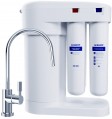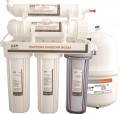Stages of purification
The number of purification stages provided for in the filter design. At each stage, water passes through its own filter element, clearing itself of certain contaminants; in this case, the steps are arranged in order from coarser cleaning to finer. For example,
a three-stage system may look like this: the first stage is mechanical removal of impurities, the second stage is the removal of ferrous, and the third is filtration through a carbon cartridge.
The more stages of purification — the more advanced the filter is considered, the cleaner water it usually provides at the outlet. Accordingly, this moment largely depends on the purpose (see “Type”): for example, multi-stage filtration is quite rare in main models, it is practically not used at all in pre-filters, but the number of stages can reach 9 in models for sink.
Pollution clipping
The smallest size of foreign particles (in microns) that the filter can hold in total. Accordingly, the smaller this size, the higher the filtration efficiency, the less undissolved impurities remain in the filtered water. On the other hand, finer cleaning usually takes more time, which affects the speed (throughput) of the filter. It should be noted that in the case of using reverse osmosis filters, the filtration is very fine, up to 0.01 microns.
Resource
The resource can be described as the total amount of water (in thousands of liters) that the filter is able to clean before the cartridge needs to be changed. Usually, it is indicated for a standard filter element (see "Removable cartridges").
Different types of filters (see above) can significantly differ in resource, depending on the features of their application. However, for all models, the rule applies: do not use a cartridge that has exhausted its resource. This is due not only to a drop in filtration efficiency — an “overfilled” filter can begin to release the accumulated contents into the water, further degrading its quality. Since it can be quite difficult to monitor of a specific amount of treated water, many manufacturers indicate the approximate time in which it will be exhausted with an average intensity of use in addition to the resource. Usually it is a few months, but there are exceptions. In addition, for the convenience of the user, various indicators can be provided in the filter design (see "Cartridge replacement indicator").
In models with a multi-stage design (see "Stages of purification"), where there are several cartridges, their resource usually differs, and the total filter resource is usually indicated by the least durable cartridge, that is, until the first replacement of any of the filter elements.
Water mineralization
The presence of a
water mineralizer in the filter design. The mineralizer is usually a container filled with a special slowly dissolving mixture. Thanks to it, filtered water is saturated with various micronutrients: calcium, potassium, fluorine, ferrous (of course, not harmful colloidal ferrous, but another easily digestible form) and others. They have a positive effect on the human body and improve the taste of the water itself compared to completely purified water.
Mineralizers are found mainly in filters equipped with reverse osmosis systems (see above): the fact is that during the operation of such systems, not only harmful impurities are removed from the water, but also the mentioned micronutrients that got there naturally.
Min. operating pressure
The lowest inlet water pressure at which the filter is able to fully perform its functions. Indicated for models with a connection to the water supply — directly or through a tap (see "Connection").
The design of some filters requires a certain level of inlet pressure for normal operation; if the pressure is insufficient, both throughput and overall filter efficiency suffer, and some functions are not available at all. The latter is especially true for reverse osmosis (see above). Therefore, if the minimum operating pressure is directly indicated in the filter characteristics, you should make sure that your water supply system complies with this parameter before purchasing.
Note that for filters with a booster pump, this column indicates the lowest pressure at which the filter still does not require the use of a pump; see "Pump" for details.
Max. operating pressure
The highest inlet water pressure at which a filter connected to a tap or water supply can operate indefinitely (at least until the resource is exhausted, see above) without breakdowns, failures, etc. In other words, this is the ultimate strength of the filter. Therefore, this parameter has a great importance, and when choosing a filter, you must make sure that it meets the characteristics of the connection point. In this case, it is best to choose a model with a margin: although the device will not break from short-term pressure surges in excess of the working device, but this will create off-design loads and can lead to early failure.
When buying a filter for ordinary domestic use, it can be assumed that the maximum pressure in the water supply, provided for by the housing and communal services standards of most post-Soviet countries, represents 6 atm, but its actual value is usually lower. Therefore, 6 atm filters are quite suitable for the definition of a “model with a margin” for apartments with medium and especially low water pressure.
Max operating temperature
The highest inlet water temperature at which the filter is able to operate normally. Modern filters are conditionally divided into models for cold and hot water: the operating temperature in the first case does not exceed 40 °C, and in the second it can reach 95 °C. For more information on the importance of matching water temperature and filter characteristics, see "Purpose".
Cartridge size
The cartridge size indicates both the overall dimensions of the device and compatibility with non-native accessories from other manufacturers. Cartridges differ in width and height, measured in inches. Among the most common options are
5SL (5"x2.5"),
10SL (10"x2.5"),
20SL (20"x2.5"),
10BB (10"x4.5"),
20BB (20"x4.5").
Standard sizes also include
inline cartridges in the form of modules made from white or transparent plastic. They are a sealed cylinder with pre-installed inlet and outlet fittings. Inline cartridges are connected via threaded connections or fittings, simplifying the replacement process. They do not require a separate housing for installation, as their design allows for direct connection to the pipeline or filtration system. They are also slimmer than traditional filters, making a filter with inline cartridges quite presentable in appearance.
Some water purification systems have cartridges in
proprietary sizes that are only compatible with specific filters. These cartridges are ideal for these systems, providing high purification efficiency. They often combine several filtration stages in one element (e.g., mechanical cleaning, chlorine removal, mineralization). This simplifies system maintenance and improve
...s water quality. Proprietary products undergo strict quality control and are tested for compatibility with specific filtering systems, ensuring stable performance. However, there are drawbacks—proprietary cartridges are more expensive and their range is much smaller than universal ones.Replacement cartridges
Models of replaceable cartridges for which the filter is designed. Knowing the names of models, it will be much easier for you to find a replacement for an exhausted cartridge. In addition, the options directly named by the manufacturer are fully compatible with the filter and correspond to official specifications, while there is no such guarantee for "non-native" cartridges.
Several names in this paragraph are usually indicated for filters with multi-stage filtration (see "Stages of purification") — a cartridge for each stage.

